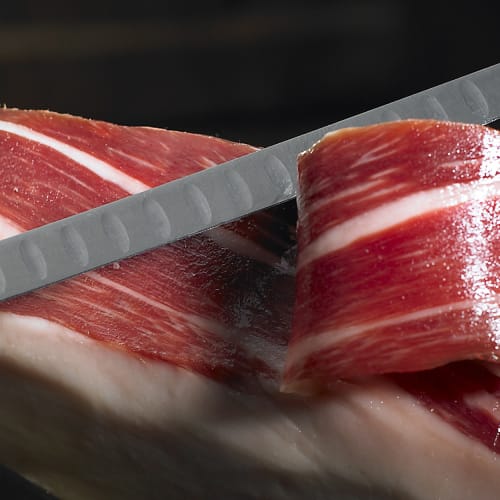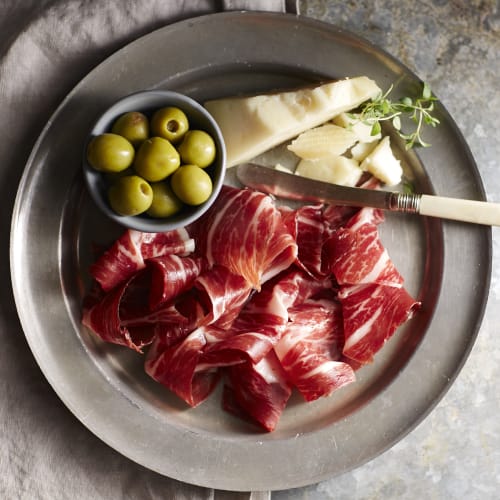About Jamón Ibérico
May 2024




The Finest Ham in the World
The story of Jamón Ibérico ham is steeped in mystery and romance. The ancient oak pastures of Spain, the noble black Ibérico pig, the mountain air which caresses each ham as it magically is transformed into one of the world's most exquisite foods - all play a part in this uniquely Spanish phenomenon. Without each ingredient the recipe is disturbed. Greatness can only be achieved with patience, skill and adherence to traditional methods.
The Pig
The origin of the Ibérico pig goes back millennia, even to the time of the cavemen who decorated the caves of Spain with their art. These are the original swine of Spain, tamed over the centuries. Only in the last couple of hundred years have the pink pigs of our imagination invaded their territory. The Ibérico hog is big, with slender legs and a very long snout. Ibérico pigs are black, with very little hair. They have black hooves as well, which is the source of the phrase “pata negra” which describes the black hoof that remains on the ham throughout the curing process and distinguishes it from a Serrano ham. They are also much fatter animals with veins of fat running through the muscle of the pig. This, along with the large amount of fat layering each ham, allows the Ibérico hams to be cured much longer, resulting in a much more complex, intense flavor, with a note of sweetness that is unparalleled. Here we must make a very important point – not all Ibérico pigs win the Jamón Ibérico lottery and live free in the Spanish countryside. Most Jamón Ibérico is made from Ibérico pigs who live normal pig lives eating corn and other feed. It is still an excellent ham, benefiting from the noble lineage of the Ibérico pig. But for the ultimate ham, you must add 'bellota', or acorns. As an indication of the difference, Jamón Ibérico de Bellota can cost twice as much as a normal Ibéricoham. So note well the difference between the two main types of Ibérico ham: there is Jamón Ibérico, and then there is Jamón Ibérico de Bellota, or acorn fed. If they are lucky enough to be destined for Bellota status, the Ibéricopigs finish their lives on the Dehesa (more on this later), in small family clans, until their day of “sacrifice” arrives. The favorite pastime of Ibérico hogs is rooting around the pastures in the Dehesa, foraging for acorns as well as herbs and grasses. All this running around feasting, especially during the acorn season, does more than make for a well rounded, happy pig. It makes for exquisitely marbled raw material, packed with natural antioxidants – a key ingredient for extended curing of the ham.
The Dehesa and the Acorn
Which brings us to the humble acorn, known as the 'bellota'. Many centuries ago, the rulers of western Spain decreed that each town and village should create pastures studded with oak trees, called the Dehesa, for the long term stability of the region. This forest/pasture continues to serve many purposes. The Holm and cork oaks provide firewood for the people, shade for the plants and livestock, cork products, and acorns (bellota) during fall and winter. During the spring and summer, cattle and sheep graze the fields. During the fall and winter, when the acorns are falling from the trees, the pigs are released to fatten up. This ancient human-created ecosystem survives intact to this day. An aside: with the construction boom in modern Spain there has been pressure on the owners of the Dehesa to convert it into real estate for homes and apartments. The renaissance of the Ibérico ham, which began less than thirty years ago, is a major ingredient in preserving this jewel of Spain for future generations. Ibérico pigs love acorns. I mean they really love acorns. Each pig can eat ten kilos of acorns a day. When the pigs destined to be Bellota hams are released onto the Dehesa at the age of about 10 months they weigh in about 200 pounds each. The once svelte young pigs become gleeful plump pigs, gaining up to 2 pounds of fat each day. After 3 to 4 months of the period known as the ‘montanera’ each pig roughly doubles its weight. In the winter, once they have reached a certain weight, their time has arrived for the ‘sacrifice’ (Both male and female pigs participate in the montanera. All are neutered and spayed; the males to protect the quality of their meat, and the females to protect them from the attentions of wild boars from the mountains.)
The Curing Process
The 'matanza', or sacrifice, has traditionally been a family affair. A pig would be slaughtered and the whole family would gather to preserve the meat for the rest of the year. Chorizo, salchichón and morcilla sausages would be made on the spot. Choice cuts would be set aside to be eaten fresh. And the fatty legs would be packed in sea salt and hung to dry in the cool winter air. This process still continues in some towns as it has for thousands of years. And over the last century, family factories have begun curing these hams in large quantities using the same methods. The hams are left to absorb the salt for a few weeks. Then they are hung in factories that still have open windows to allow the mountain air to circulate around the hams. Ibérico hams cure for two to four years. Ibérico hams usually about two years, Ibérico Bellota hams for longer periods. This extraordinarily long curing process is possible because of the huge amount of fat on each ham and, in the case of the Bellota hams, the antioxidant quality of their diets. Over the curing period they lose nearly half their weight as the fat drips away. An incredible transformation occurs as the winter moves to spring and summer. The salted ham starts to sweat. Because of the salt, bacteria cannot take hold, but massive chemical changes occur. The meat becomes dryer, and cools off as the second winter commences. The special aspect of Ibérico is that it can go through this cycle two or three times. The result is a build up of complex, volatile molecules in the ham that transform it from a piece of pork into an orchestra of flavors. With the Bellota hams, the most miraculous transformation is of the fats. Through this period of heating and cooling, salting and drying, the fats are broken down. Because of the antioxidants in the acorns and the unique curing process, the saturated fats are changed into healthy mono-unsaturated fats high in oleic acid. The only fat higher in oleic acid is olive oil.
The Ham
The ultimate result is a long, thin leg of ham with a deep golden hue to its fat. The meat is dark red and well marbled. We had an incredible experience in the city of Caceres. There Pedro Lancho, the owner of Encinar de Cabazón, served us a feast fit for a king. The highlight was when the professional waiter at his favorite restaurant brought out plates of his Gran Reserva Jamón Ibérico de Bellota. It was served in paper thin slices on a plate that was warmed to about 75 degrees. At that temperature the fat literally melted onto the plate. On first bite, the flavor of the ham was incredible. Sweet, nutty, and not too salty. Then the complexity of ham flavors increased. An essential part of the flavor and mouth-feel was the way the fat melted away, releasing flavors that told the story of the noble Ibérico swine, of the Dehesa forest pasture, of the years of careful curing, and of the countryside of Spain itself.

